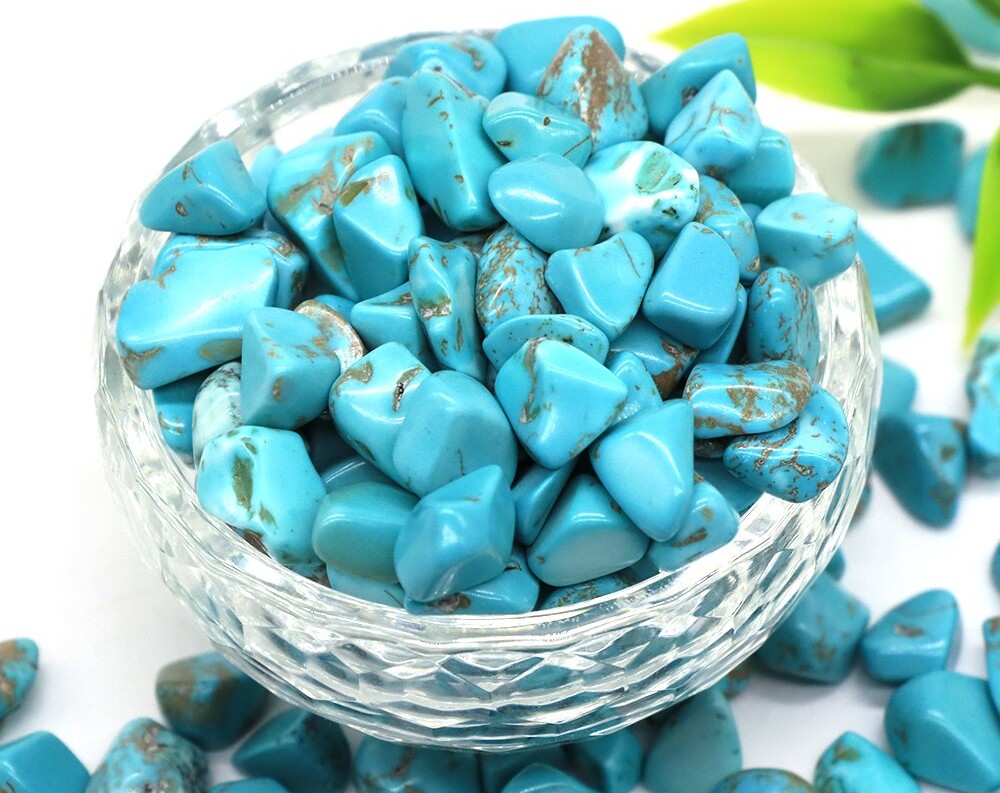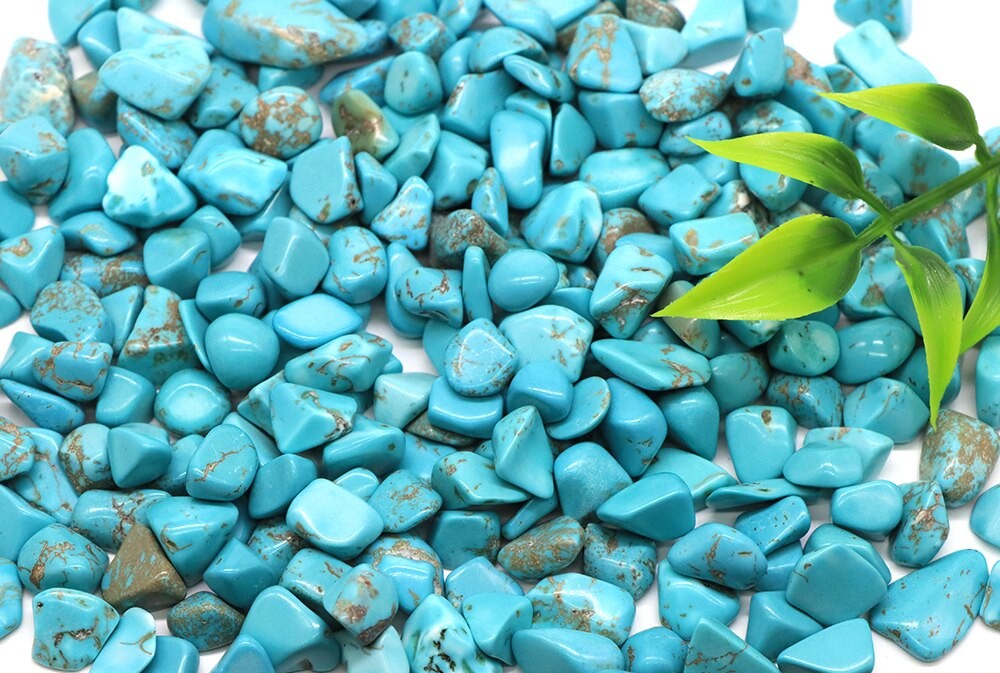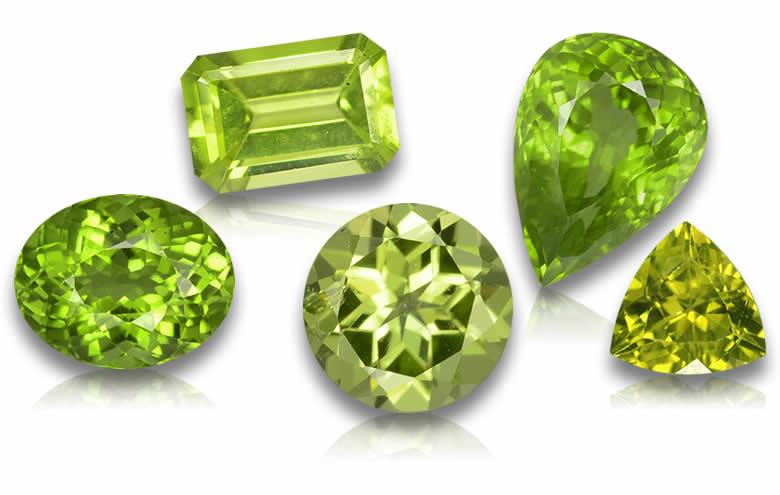Quick info about Turquoise Birthstone
- Official birthstone: December
- Colors: Predominantly blue-green, but can also vary from green to sky blue
- Meaning: Protection, wisdom, and good fortune
- Zodiac signs: Sagittarius and Capricorn
- Mohs hardness: 5 to 6
Birthstones have long held a special place in human culture and hold significant meaning to those born in each corresponding month. These gemstones are believed to possess unique properties and symbolism that resonate with the individuals who bear them.
In this regard, December stands out with its enchanting birthstone: turquoise. With its vibrant hues and fascinating history, turquoise captures the essence of winter, making it a perfect gemstone to represent the final month of the year.
Brief Overview of Birthstones and Their Significance
The concept of birthstones can be traced back thousands of years, across various cultures and civilizations. It is widely speculated that the tradition originated from ancient Hebrew beliefs, where twelve stones representing the twelve tribes of Israel were associated with different months.
Over time, this idea spread across cultures and evolved into what we know today. Each birthstone carries significance that is believed to influence its wearer’s life in various ways.
These gemstones are thought to bring good luck, health, protection, and other positive attributes associated with their specific qualities. As such, wearing one’s birthstone has become a popular tradition worldwide.
Introduction to Turquoise as the December Birthstone
Turquoise stands proudly as the designated birthstone for December. Its name derives from “Pierre Turquoise,” meaning “Turkish stone,” as it was initially introduced to Europe through Turkish trade routes during the 13th century. This captivating gemstone is renowned for its stunning blue-green hues reminiscent of tropical waters or cloudless skies.
The color range varies from delicate sky blues to deeper shades with green undertones – all evoking feelings of tranquility and serenity. Aside from its visual allure, turquoise possesses a rich historical legacy throughout many civilizations around the globe.
Its significance spans cultures and continents, making it a gemstone steeped in myth, lore, and spiritual symbolism. This cherished stone not only captivates the eye but also has the power to captivate the heart and soul.

Historical Significance of Turquoise
Ancient Civilizations that Valued and Used Turquoise
Turquoise has a rich history dating back thousands of years, where it was highly valued and revered by various ancient civilizations. The Egyptians, Persians, and Native American tribes are notable examples of cultures that recognized the unique beauty and significance of this striking gemstone.
Egyptians and their Use of Turquoise in Jewelry and Amulets
The ancient Egyptians held turquoise in high regard, considering it a symbol of rebirth and protection. This captivating gemstone was used extensively in their intricate jewelry designs, with turquoise beads adorning necklaces, bracelets, and rings.
The color contrast between the vibrant blue-green hues of turquoise against precious metals like gold emphasized its allure. Additionally, turquoise amulets were frequently carved into symbolic shapes such as scarabs or eyes to provide spiritual protection to the wearer.
Persians and their Belief in the Protective Powers of Turquoise
In Persian culture, turquoise played a significant role as a talisman for protection against evil forces. They believed that wearing turquoise stones could ward off negativity while bringing good fortune to the wearer.
The Persians also adorned their ceremonial robes with large cabochon-cut turquoise gems as a signifier of power and prestige. It was believed that these brilliant stones possessed divine qualities that could safeguard individuals from harm.
Native American Tribes’ Reverence for Turquoise as a Sacred Stone
Turquoise holds immense cultural importance among Native American tribes across North America. Many tribes considered it a sacred stone imbued with healing properties for both physical ailments and spiritual alignment.
The Navajo tribe regarded turquoise as a representation of prosperity and abundance, using it extensively in their jewelry craftsmanship. Similarly, the Zuni tribe believed that turquoise had great transformative powers and incorporated it into intricate inlay work, creating stunning mosaic-like patterns.
Turquoise’s connection to ancient civilizations reveals its enduring significance as a gemstone deeply embedded within human cultural history. From the Egyptians’ passion for incorporating turquoise into their jewelry and amulets to the Persians’ belief in its protective powers and the Native American tribes’ reverence for its sacred qualities, turquoise continues to captivate our fascination with its vibrant beauty and spiritual symbolism.
Geological Formation of Turquoise
Explanation of how turquoise is formed
Turquoise, a captivating gemstone revered for its unique blue-green hues, is formed through a fascinating geological process that spans millions of years. The formation begins with the presence of copper minerals in arid regions characterized by specific geological conditions. Copper deposits, such as chrysocolla and azurite, are often found in areas rich in volcanic activity or near mineral-rich veins.
Presence of copper minerals in arid regions with specific geological conditions
Copper minerals, the primary contributors to turquoise formation, are commonly found in arid regions where water scarcity and specific geological conditions prevail. These areas include desert environments with low rainfall and high evaporation rates.
Regions such as Iran, Afghanistan, and the southwestern United States possess the ideal combination of climatic factors necessary for turquoise formation. The presence of copper minerals alone is not sufficient to create turquoise.
Other elements play a crucial role in this process, including aluminum and phosphorus. These elements interact with the copper minerals under specific environmental conditions to facilitate the conversion into turquoise.
Interaction between copper minerals, water, and other elements over millions of years
The geological process behind turquoise formation involves an intricate dance between copper-bearing solutions and water within rock formations over extended periods. As rainwater or groundwater percolates through porous rocks containing copper deposits, it creates a chemical reaction known as hydration. This hydration process results from the interaction between water molecules and copper ions present within the rocks.
Over time—often spanning millions of years—the water molecules break down complex crystal structures while incorporating new elements like aluminum and phosphorus into the mix. As this transformation continues to unfold deep within the earth’s crust, turquoise begins to crystallize slowly.
The distinct color variations observed in different specimens arise from various factors such as iron content, oxidation, and the presence of other trace minerals during the formation process. Turquoise’s geological formation is a remarkable journey that involves the interaction between copper minerals, water, and other elements over vast expanses of time.
The combination of specific arid conditions, the presence of copper minerals in volcanic or mineral-rich areas, and the subsequent hydration process catalyzes the conversion of these minerals into mesmerizing turquoise gemstones. Understanding this intricate process adds depth to our appreciation for this December birthstone’s beauty and allure.

Physical Properties of Turquoise
Color Variations and Factors Influencing Them
Turquoise, with its mesmerizing hues, showcases a wide range of colors that captivate the beholder. From ethereal sky blues to enchanting greenish-blue shades, the variations in turquoise’s color are influenced by several factors. The primary element that determines its color is copper, which imparts a tempting blue tone to the gemstone.
However, the presence of iron can alter this hue, resulting in tones ranging from pale blue to deep green. Therefore, it is common to find turquoise with subtle transitions or intriguing mottled patterns caused by varying mineral compositions within its geological formation.
Influence of Iron Content on Color Intensity
The intensity and saturation of turquoise’s color depend heavily on the iron content within its structure. Generally, higher levels of iron tend to produce more vibrant and intense shades of blue in turquoise gemstones. This attribute becomes particularly prominent when comparing two specimens from different sources; for instance, Persian turquoise often exhibits a more striking and vivid blue due to higher iron concentrations compared to mines in other regions.
Hardness and Durability
While admired for its delicate beauty, it is crucial to acknowledge that turquoise possesses moderate hardness compared to many other gemstones. On the Mohs scale of mineral hardness ranging from 1 (softest) to 10 (hardest), turquoise typically falls between 5 and 6.
This indicates that it can be susceptible to scratches and abrasions if not handled with care or exposed recklessly to harsh substances. Moreover, due to its relatively porous nature, prolonged exposure to oils, cosmetics, perfumes, or household chemicals can cause damage or alteration in color.
Explanation of Its Porous Nature Making It Susceptible To Damage
One notable characteristic of turquoise is its porous composition, which arises from its formation in arid regions where water interacts with copper minerals over millions of years. This porosity makes turquoise more vulnerable to external factors and susceptible to damage.
Moisture, for instance, can seep into the gemstone, leading to discoloration or even the development of cracks over time. To preserve the longevity of turquoise jewelry or artifacts, it is advised to avoid contact with water whenever possible and store them in a cool, dry environment.
By understanding these physical properties of turquoise – the mesmerizing color variations influenced by copper and iron content along with its relative softness and porous nature – one gains a deeper appreciation for this captivating gemstone. Despite its delicate nature, when cared for properly, turquoise can retain its allure and continue to captivate generations to come.
Turquoise Mining Locations around the World
Major Global Sources for High-Quality Turquoise
Turquoise, with its captivating beauty and historical significance, has been mined across various regions worldwide. Let us explore some of the major global sources renowned for their production of high-quality turquoise. These mining locations have yielded exceptional specimens that have adorned jewelry and captivated collectors for centuries.
Iran – Renowned for Producing Some of the Finest Persian Turquoise
Iran stands as one of the most esteemed sources for Persian turquoise, renowned for producing some of the finest specimens in the world. The country’s rich history and deep-rooted tradition in turquoise mining date back thousands of years.
Iranian turquoise is highly regarded for its stunning sky-blue to greenish-blue hues, often displaying intricate matrix patterns that enhance its visual appeal. Mines such as Neyshabur and Nishapur have been pivotal in extracting this prized gemstone from beneath Iran’s ancient desert landscapes.
Afghanistan – Known for its Vibrant Blue-Green Stones with Black Spiderweb Patterns
Afghanistan has long been associated with turquoise mining, known particularly for producing vibrant blue-green stones adorned with striking black spiderweb-like patterns. The country’s mines have yielded exceptional specimens sought-after by collectors and jewelry artisans alike. The Sar-e-Sang mine, nestled within Afghanistan’s awe-inspiring mountainous regions, has been a prominent source of high-quality Afghan turquoise throughout history.
United States – Notable Mines in Arizona, Nevada, New Mexico, Colorado
The United States boasts an array of notable turquoise mines scattered across different states such as Arizona, Nevada, New Mexico, and Colorado. Each region offers unique variations in color and matrix patterns that contribute to the distinctiveness of American turquoise. Arizona’s Sleeping Beauty Mine is celebrated worldwide due to its production of vivid sky-blue turquoise devoid of any matrix.
Nevada’s Royston Mine is renowned for its beautiful blue and green stones, often featuring golden-brown matrix patterns, while New Mexico’s famous Cerrillos Mine produces a wide range of turquoise colors, including vibrant blue and green hues with intricate spiderweb-like matrices. Additionally, Colorado’s Kingman Mine stands out for its deep blue and green stones with captivating black matrices.
These mining locations serve as the primary sources of high-quality turquoise across the globe. Their unique geological conditions have fostered the formation of this enchanting gemstone, each offering distinctive characteristics that make their turquoise highly sought-after by both connoisseurs and jewelry enthusiasts alike.
Turquoise Symbolism & Folklore
The Mystical Connection of Turquoise
Turquoise has been revered throughout history for its mystical and symbolic qualities. Across various cultures, it has been associated with protection, wisdom, and spiritual enlightenment. In many belief systems, turquoise is believed to have a direct connection to the celestial realm, acting as a bridge between the earthly and divine realms.
Cultural Significance across Different Societies
From ancient civilizations to modern societies, turquoise holds a special place in cultural traditions around the world. It is not only cherished as a beautiful gemstone but also deeply intertwined with religious rituals, healing practices, and personal adornment.
In Middle Eastern cultures like Persia (modern-day Iran), turquoise is considered a sacred stone that wards off evil spirits and brings good fortune. In Chinese culture, turquoise symbolizes wealth and prosperity.
It is often used in jewelry designs and displayed in homes to attract positive energy and abundance. Tibetan Buddhists believe that wearing turquoise can enhance spiritual communication and protect against negative energies.
Native American Tribes’ Belief in the Healing Properties of Turquoise
Traditional Medicine Wheel Teachings
For Native American tribes such as the Navajo, Hopi, Zuni, and Pueblo peoples, turquoise holds immense spiritual significance. They view turquoises as gifts from Mother Earth or sky stones embodying the colors of the sky reflecting on water bodies.
These tribes believe that wearing or carrying turquoise enhances their connection with nature’s elements like water and sky. According to Native American tradition, turquoise possesses healing properties that promote physical well-being and emotional balance.
It is believed to bring about strength, protection against harm or evil spirits while promoting positive energy flow within the body. The Navajo people associate turquoise with rainwater – a life-giving force in arid regions.
They see it as a symbol of good health, fertility, and abundance. The Hopi tribe values turquoise for its connection to the spirits of ancestors, using it in rituals and ceremonies to invoke blessings and healing energies.
Conclusion
Turquoise stands as a gemstone that transcends mere beauty. Its historical significance and cultural symbolism make it a truly captivating stone. From ancient civilizations harnessing its protective powers to Native American tribes utilizing its healing properties, turquoise has woven a rich tapestry of awe-inspiring mythology.
So next time you admire the mesmerizing hues of turquoise, let yourself be reminded of the profound wisdom and spiritual connection this December birthstone holds. Embrace its allure and allow its vibrant energy to uplift your spirit with positivity and inspiration.





